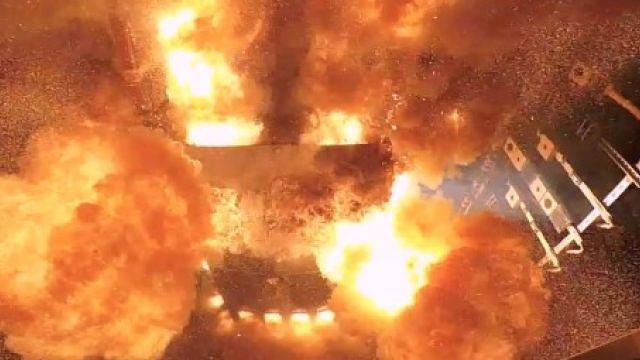
Hot Topic: GRS Research on Fire Protection in Nuclear Power Plants
The NEA is an official institution within the Organisation for Economic Co-operation (OECD) that facilitates and coordinates the cooperation of states with advanced nuclear infrastructure. This is to promote and improve areas such as nuclear safety, technology, science or legislation. The NEA maintains several specialised standing technical committees, two of which are directly related to NPP safety: the CNRA (Committee on Nuclear Regulatory Activities) and the CSNI (Committee on the Safety of Nuclear Installations).
These committees are composed of international experts, mostly representatives of national technical safety organisations as well as licensing and regulatory authorities. While the CNRA deals with regulatory, licensing and supervisory issues related to NPPs, the CSNI aims to promote technical cooperation among NEA member states in the field of nuclear safety of NPPs and research reactors. CSNI’s main tasks are
- to exchange technical information,
- to promote collaboration between research, development, engineering and regulation organisations,
- to review the state of knowledge on selected topics of nuclear safety technology and safety assessments, including operating experience, and
- to promote coordination of work aimed at maintaining competence in nuclear safety.
A large number of research projects are carried out for this purpose. GRS officially represents Germany in the CSNI and has also participated in almost all CSNI projects in the past. Germany's financial participation in these projects is largely funded by the Federal Ministry for Economic Affairs and Energy (BMWi) and partly by the Federal Ministry for the Environment (BMU). A current experimental project with GRS participation is the HEAF (High Energy Arcing Fault) project, which is now in its second phase.
Arcing faults as a potential cause of fire
What is HEAF about? Operating experience from nuclear facilities has shown that a specific component failure of electrical equipment in the medium- and especially high-voltage range (e.g. switchgears, circuit breakers or bus bars, typically with nominal voltages in the range of more than 380 V) can occur, which is a high energy arcing fault (HEAF). In the case of an arcing fault, a considerable release of energy in the form of heat (up to 10,000 °C) occurs within a very short time. Metals (e.g. copper or aluminum) vaporise, a gaseous plasma is formed and an extreme pressure build-up occurs within the components with explosive failure.
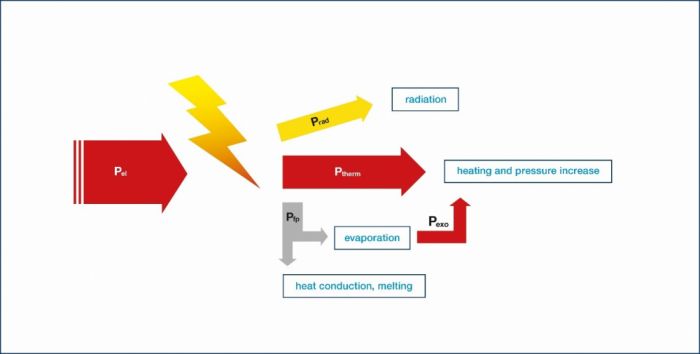
In a HEAF scenario, two successive phases are typically distinguished, each with its own damage patterns. The first phase is characterised by an extremely short and rapid release of energy from the arc of typically 100 kcal/m2. This energy release can result in
- a complete functional failure of the affected component,
- the ejection of hot projectiles from damaged electrical components or the component housing, and
- a subsequent fire due to the extremely high temperatures.
In the case of such fires, either only the component in which the arcing fault occurred or other components located in the immediate vicinity may be affected. In the second phase, the fire caused by the arcing fault typically spreads to all combustible materials in the immediate area of influence of the arcing fault, which is called the HEAF zone of influence (ZOI).
HEAF events can affect safety in nuclear power plants
International operating experience from nuclear power plants, which is documented in the international database for fire incidents in nuclear power plants FIRE (Fire Incidents Records Exchange) of the OECD/NEA, indicates that arcing faults from medium- and high-voltage circuit breakers can lead to fires. At the same time, however, they can also cause considerable damage to fire protection equipment (especially walls or doors).
Based on these findings, a first series of large-scale experiments took place under the auspices of the OECD/NEA as early as from 2012, which confirmed the observations from operating experience. The experts and representatives of the authorities involved in this project concluded from this that arcing faults should be taken into account in the fire hazard analysis as well as in the fire-related parts of a probabilistic safety analysis (PSA) for an adequate safety assessment of nuclear facilities. In addition, regulatory guidelines for the control of arcing faults and for fires caused by them would be required.
In order to conduct experiments on HEAF events with subsequent fires as they can occur in nuclear power plants as realistic as possible (see video), a second phase of the HEAF experimental project (HEAF, Phase 2) has been running since autumn 2018 under the auspices of the OECD/NEA. The knowledge gained will then be used to derive rules and calculate models for such events.
Results of high interest to the nuclear regulatory authorities
The first phase dealt in particular with the phenomenon of arcing faults and possible subsequent fires, whereas the second phase of the project should now enable conclusions to be drawn for improving the safety of NPPs in operation. A large number of the NPPs currently in operation worldwide have switchgears that could fail due to arcing faults. Accordingly, there is considerable interest on the part of the requlatory authorities in these real-scale experiments and their results. There is a risk potential from HEAF events, of course, also in the dismantling phase.
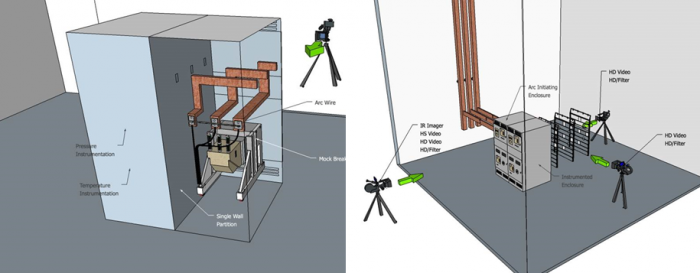
The current planning of the OECD/NEA experiments and supplemental testing specifically covering the situation in US nuclear power plants reflects the efforts to approach the overall phenomenon of arcing faults in a step-by-step procedure. Both experimental test series are carried out by the Office of Research of the US regulatory authority, the Nuclear Regulatory Commission (NRC).
One of the results of the first phase was the different behaviour of components with aluminum conductors compared to those with copper conductors. In the presence of aluminum, a conductive mixture is formed, which leads to significantly more extensive damage than in the presence of copper.
In a first step, the focus is on HEAF events in the presence of aluminum, as is typical for US components – regardless of whether the aluminum is located in the respective component itself or is part of its enclosure. The experiments will reflect both the thermal conditions of such scenarios and the pressure build-up and deposition of (possibly conductive) waste products on surfaces due to arcing faults in bus bars or switchgear cabinets. The scientists expect quantitative results regarding the impacts of arcing faults on corresponding components (so-called targets) in rooms with electrical equipment and cables.
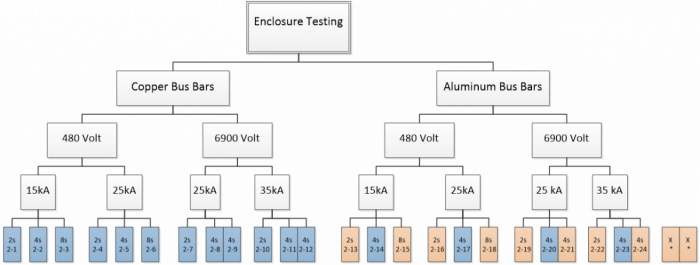
In a second step, the OECD/NEA-specific experimental tests are carried out on bus bars and switchgears in corresponding enclosures. This also includes tests with switchgear cabinets as used in European NPPs. Regulatory authorities such as the BMU or the Dutch Authority for Nuclear Safety and Radiation Protection (ANVS) are participating in the current second phase of HEAF. A German operator has provided corresponding medium- and high-voltage switchgears from a NPP being dismantled. GRS organised the dismantling and transport of the components to the USA. This work was financed by the BMU and ANVS. The tests are to be completed by the end of 2022.
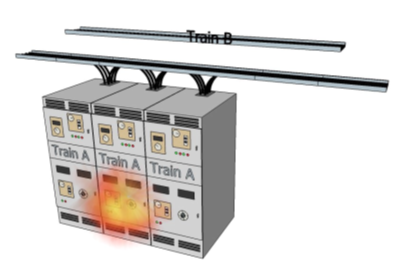
For details on the HEAF 2 experimental setup see:
Röwekamp, M., H.-P. Berg (ed.): Proceedings of SMiRT 25, 16th International Seminar on Fire Safety in Nuclear Power Plants and Installations, October 28–30, 2019, Ottawa, ONT, Canada, GRS-A-3963, Gesellschaft für Anlagen- und Reaktorsicherheit (GRS) gGmbH, Köln, Germany, December 2019, https://www.grs.de/en/publication/grs-3963.